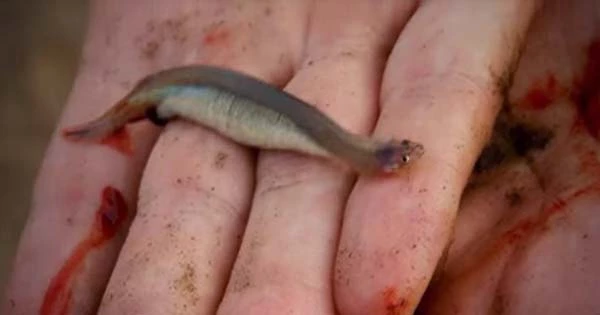The candiru catfish is a fish with a shady reputation. If someone stops to pee in the freshwaters that surround South America’s rainforests, they may find a “toothpick fish” trapped up their urethra, according to mythology. While the veracity of such reports is dubious at best, certain candirus have discovered various ways to infiltrate humans. They are also known as vampire candirus because of their voracious appetite for blood. To eat, they would swim through fish gills and grab onto main blood arteries — a habit that is said to have spurred them to swim up microscopic gaps of all kinds.
While urethras seem a stretch, a case paper published in the Journal of the Brazilian Society of Tropical Medicine in 2021 details how one “human-biting candiru” grabbed onto a person’s skin to receive a bellyful of blood. A photo description from the article states, “The human-biting candiru from the subfamily Vandelliinae, a portion of a scientifically undescribed genus and species latched to the back of a youngster.”
“The fish’s mouth leaves a bleeding [oval] lesion at the attachment location after a vigorous removal.” The candiru’s belly is dripping with blood, and it has a firm grip on the victim, with another bite to the right of the leaking one.” Proceed with care as the next image includes blood.
Human bites by candiru catfish are uncommon, but not unheard of. The majority of these fish avoid eating living humans, but corpses are a different story. Candirus, a carrion-eating whale, eats the carcasses of river dolphins and other dead animals, including humans, however two species have differing eating habits. Cetopsis candiru will whirl after biting into a corpse, producing a tidy tunnel into the tissue that it can utilize to enter the body cavity and consume it from the inside out. These fish will swarm in feeding frenzy, sometimes by the hundreds.
The candiru Ceptosis coecutiens adopts a different strategy, tearing portions off with fast bites and rips before returning for another feeding. Both fish have been seen eating on human corpses, and their bites have left circular imprints on skull bones. Reports of attacks by the as-yet-undescribed “human-biting candiru,” as the authors refer to it, reveal that some of these fish have a thirst for our blood as well. They can latch onto human skin with specialized teeth and hang on with powerful head muscles, making them tough to remove while feeding on blood. While most accounts of candiru fishes attacking humans appear to be based on legend, it appears that the human-biting candiru has different ideas.















